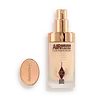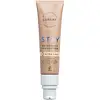What's inside
What's inside
 Key Ingredients
Key Ingredients

 Benefits
Benefits

 Concerns
Concerns

 Ingredients Side-by-side
Ingredients Side-by-side

Water
Skin ConditioningCyclopentasiloxane
EmollientIsododecane
EmollientPEG-10 Dimethicone
Skin ConditioningPropanediol
SolventPolyglyceryl-4 Isostearate
EmulsifyingSilica
AbrasiveNylon-12
Phenoxyethanol
PreservativeDisteardimonium Hectorite
StabilisingPolysorbate 20
EmulsifyingDimethyl Isosorbide
SolventDimethicone Crosspolymer
Emulsion StabilisingTriethoxycaprylylsilane
Menthyl PCA
HumectantSodium Dehydroacetate
PreservativeArginine PCA
HumectantAluminum Hydroxide
EmollientTocopheryl Acetate
AntioxidantParfum
MaskingIsomalt
HumectantSodium Phytate
Phaeodactylum Tricornutum Extract
HumectantAcetyl Tetrapeptide-11
Skin ConditioningAcetyl Tetrapeptide-9
Skin ConditioningAlcohol
AntimicrobialPhytol
EmollientAlpha-Isomethyl Ionone
PerfumingBenzyl Salicylate
PerfumingCitronellol
PerfumingLimonene
PerfumingCI 77891
Cosmetic ColorantIron Oxides
Water, Cyclopentasiloxane, Isododecane, PEG-10 Dimethicone, Propanediol, Polyglyceryl-4 Isostearate, Silica, Nylon-12, Phenoxyethanol, Disteardimonium Hectorite, Polysorbate 20, Dimethyl Isosorbide, Dimethicone Crosspolymer, Triethoxycaprylylsilane, Menthyl PCA, Sodium Dehydroacetate, Arginine PCA, Aluminum Hydroxide, Tocopheryl Acetate, Parfum, Isomalt, Sodium Phytate, Phaeodactylum Tricornutum Extract, Acetyl Tetrapeptide-11, Acetyl Tetrapeptide-9, Alcohol, Phytol, Alpha-Isomethyl Ionone, Benzyl Salicylate, Citronellol, Limonene, CI 77891, Iron Oxides
Water
Skin ConditioningCaprylyl Methicone
Skin ConditioningZinc Oxide
Cosmetic ColorantLauryl PEG-10 Tris(Trimethylsiloxy)Silylethyl Dimethicone
EmulsifyingCaprylic/Capric Triglyceride
MaskingSilica
AbrasiveIsododecane
EmollientEthyl Oleate
EmollientButylene Glycol
HumectantPolyhydroxystearic Acid
EmulsifyingMagnesium Sulfate
Betaine
HumectantEmpetrum Nigrum Fruit Juice
Skin ConditioningDimethicone
EmollientPhenoxyethanol
PreservativeTrimethylsiloxysilicate
EmollientDisteardimonium Hectorite
StabilisingHydrogenated Vegetable Oil
EmollientNeopentyl Glycol Diethylhexanoate
EmollientPolypropylsilsesquioxane
Propanediol
SolventCetearyl Dimethicone Crosspolymer
Propylene Carbonate
SolventTriethoxycaprylylsilane
Ethylhexylglycerin
Skin ConditioningGlycerin
HumectantBiosaccharide Gum-1
HumectantPotassium Sorbate
PreservativeIron Oxides
CI 77891
Cosmetic ColorantWater, Caprylyl Methicone, Zinc Oxide, Lauryl PEG-10 Tris(Trimethylsiloxy)Silylethyl Dimethicone, Caprylic/Capric Triglyceride, Silica, Isododecane, Ethyl Oleate, Butylene Glycol, Polyhydroxystearic Acid, Magnesium Sulfate, Betaine, Empetrum Nigrum Fruit Juice, Dimethicone, Phenoxyethanol, Trimethylsiloxysilicate, Disteardimonium Hectorite, Hydrogenated Vegetable Oil, Neopentyl Glycol Diethylhexanoate, Polypropylsilsesquioxane, Propanediol, Cetearyl Dimethicone Crosspolymer, Propylene Carbonate, Triethoxycaprylylsilane, Ethylhexylglycerin, Glycerin, Biosaccharide Gum-1, Potassium Sorbate, Iron Oxides, CI 77891
Ingredients Explained
These ingredients are found in both products.
Ingredients higher up in an ingredient list are typically present in a larger amount.
Ci 77891 is a white pigment from Titanium dioxide. It is naturally found in minerals such as rutile and ilmenite.
It's main function is to add a white color to cosmetics. It can also be mixed with other colors to create different shades.
Ci 77891 is commonly found in sunscreens due to its ability to block UV rays.
Learn more about CI 77891Disteardimonium Hectorite comes from the clay mineral named hectorite. It is used to add thickness to a product.
It can also help stabilize a product by helping to disperse other ingredients.
Hectorite is a rare, white clay mineral.
Learn more about Disteardimonium HectoriteIsododecane is a fragrance, emollient, and solvent.
As an emollient, it helps your skin stay soft and hydrated. Emollients help trap moisture into your skin.
Isododecane's role as a solvent makes it a great texture enhancer. It spreads smoothly on skin and does not leave a sticky feeling behind. Isododecane also helps prevent color transfer in makeup products.
Isododecane is not absorbed into skin.
Learn more about IsododecanePhenoxyethanol is a preservative that has germicide, antimicrobial, and aromatic properties. Studies show that phenoxyethanol can prevent microbial growth. By itself, it has a scent that is similar to that of a rose.
It's often used in formulations along with Caprylyl Glycol to preserve the shelf life of products.
Propanediol is an all-star ingredient. It softens, hydrates, and smooths the skin.
It’s often used to:
Propanediol is not likely to cause sensitivity and considered safe to use. It is derived from corn or petroleum with a clear color and no scent.
Learn more about PropanediolSilica, also known as silicon dioxide, is a naturally occurring mineral. It is used as a fine, spherical, and porous powder in cosmetics.
Though it has exfoliant properties, the function of silica varies depending on the product.
The unique structure of silica enhances the spreadability and adds smoothness, making it a great texture enhancer.
It is also used as an active carrier, emulsifier, and mattifier due to its ability to absorb excess oil.
In some products, tiny microneedles called spicules are made from silica or hydrolyzed sponge. When you rub them in, they lightly polish away dead skin layers and enhance the penetration of active ingredients.
Learn more about SilicaTriethoxycaprylylsilane is a silicone used to bind and stabilize ingredients.
As an emulsifier, it helps prevent ingredients from separating. This can help elongate the shelf life of products.
Triethoxycaprylylsilane is often used to coat mineral sunscreens ingredients to help give a better feel. It also helps reduce oxidative stress in sunscreens.
Learn more about TriethoxycaprylylsilaneWater. It's the most common cosmetic ingredient of all. You'll usually see it at the top of ingredient lists, meaning that it makes up the largest part of the product.
So why is it so popular? Water most often acts as a solvent - this means that it helps dissolve other ingredients into the formulation.
You'll also recognize water as that liquid we all need to stay alive. If you see this, drink a glass of water. Stay hydrated!
Learn more about WaterThis ingredient is a combination of red, black, and yellow iron oxide pigments. This combination of colors is usually found in foundation, because it results in a "skin" color.